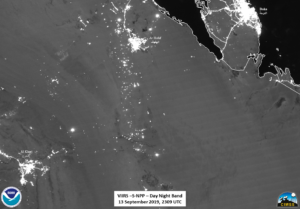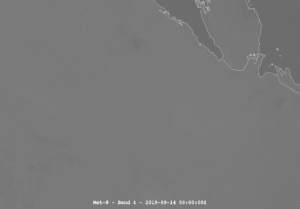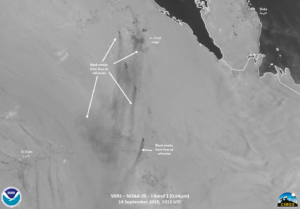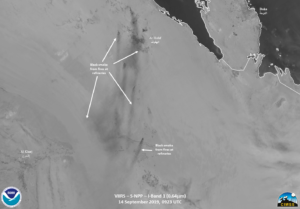« Back to "14 September 2019 Drone Strikes on Saudi Arabia"
Aftermath of attacks on Saudi Arabia refineries on 14 Sept 2019
Posted: September 14, 2019
An unprecedented attack on the two of Saudi Arabia’s key oil installations, including the Saudi Aramco processing facility in Abqaiq (بقيق) and the Khurais oil field (حقل خريص), occurred at approximately 4am Saudi Arabia Standard Time (0100UTC) on 14 September, according to media reports. It has been reported that there were possibly 19 points of impact, cutting production by roughly 5.7 million barrels per day, or roughly half the oil output of Saudi Arabia. To put it another way, this is ~5% of the world’s daily production of crude oil.
Roughly 3 hours before, at 2309UTC, SNPP got a near-nadir over pass of the region. As can be seen in the Day Night Band image below, while there are gas flares clearly seen in the imagery, this is not unexpected.
As can be seen in the Meteosat-8 imagery, the fires can easily be seen in the 3.9μm (Band 4) imagery in the below loop.
The resulting smoke from the fires as well as increased flaring from the gas-oil separation plants at the Ghawar (الغوار) oil field as a result of the strikes can easily be seen in the I01 (0.64μm) visible imagery. Again, with the fact that NOAA-20 and S-NPP were both able to see the oil fields, one could easily see the smoke was carried by the winds
This is further emphasized by the slider below
Due to the fact that the desert regions are extremely hot during the day means that the traditional IR enhancements must be heavily modified. However, algorithms, such as the VIIRS Active Fires algorithm, take care of such surface effects leading to identification of hot spots in an easy manner.
Given the nature of this incident, it is anticipated the effects will be felt worldwide, as 5% of the worldwide oil production has been turned off until repairs can be made.







